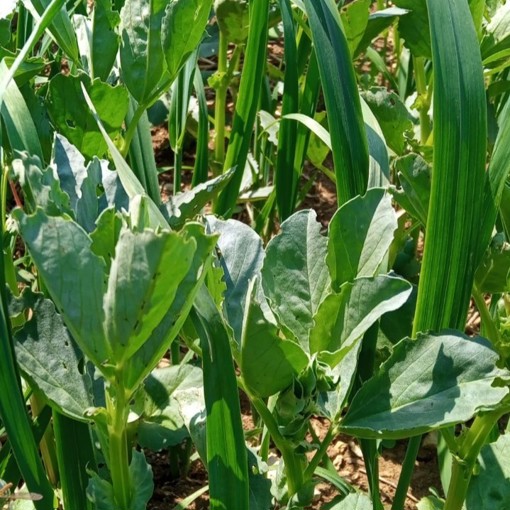Intercropping, sometimes known as polycropping, is the practice of growing two or more plant species simultaneously in the same field. It can boost crop yields by up to 30%, reduce weeds, improve soil health and increase biodiversity. In field lab run in 2019, intercropping beans and wheat reduced the weed burden by 74% for two years running.
Last week over forty farmers and researchers met at a farm workshop in Oxfordshire to share their experiences of intercropping, as part of the European project LEGUMINOSE. The event was kindly hosted by Ben Adams, who is in the middle of his own intercropping trial.

Intercropping wrongly labelled a hassle
Despite being such a sustainable and efficient way of producing food, it is still a niche practice in Europe (only 2% of arable land is used for intercropping). One organic farmer at the event, who already practices intercropping, suggested that this is because there is not enough knowledge sharing among farmers: “it’s perceived as being a hassle” he added, “but in my experience it doesn’t have to be”.
To boost knowledge and share experiences in intercropping is the main goal of the field lab and the LEGUMINOSE project in general.
The attendees separated into groups to discuss their own experiences of intercropping, and the perceived barriers and opportunities.
The barriers to intercropping
Some familiar issues were raised:
- The possible difficulty of separation
- Timing the harvest right so both crops are ready
- On-farm storage
- The potential of contamination if the crops are going to a human market.
Opportunities and benefits of the intercropping:
The group discussed some of the opportunities too.
- Reduced need for inputs (artificial fertiliser & herbicides),
- Increased biodiversity
- Spreading the risk of crop failure
- Weed suppression
- The legacy effect of the nitrogen in the soil.
Ben Adam’s farm walk
The group then went to look at Ben Adam’s 8 in-field trial plots, each with a different mix of 2 or 3 crops including beans, oats, vetch, peas, OSR and barley. Of the 8 plots the best combination at this point in the growing season was beans and oats. The oats in this plot were significantly greener than in the neighbouring plot containing oats and vetch. This raised the question of whether there was any transfer of nitrogen (N) from the beans to the oats, even at this early stage of growth, and highlighted how the relationship between intercropped legumes and cereals is not yet fully understood.

Practical considerations of intercropping
The group also discussed more practical issues, such as combining, and Ben agreed that harvest was likely to be a little more complicated than with a monocrop, especially with smaller seeds such as vetch, but he was confident they would work through it.
Ben also noted that there were other benefits of intercropping such as stackable SFI payments which made the crop even more financially rewarding.
Next event for your diaries
The next LEGUMINOSE farm workshop will be held in the autumn. For more information on the LEGUMINOSE project, or if you’re interested in taking part in the field lab, contact Jerry Alford jalford@soilassociation.org
